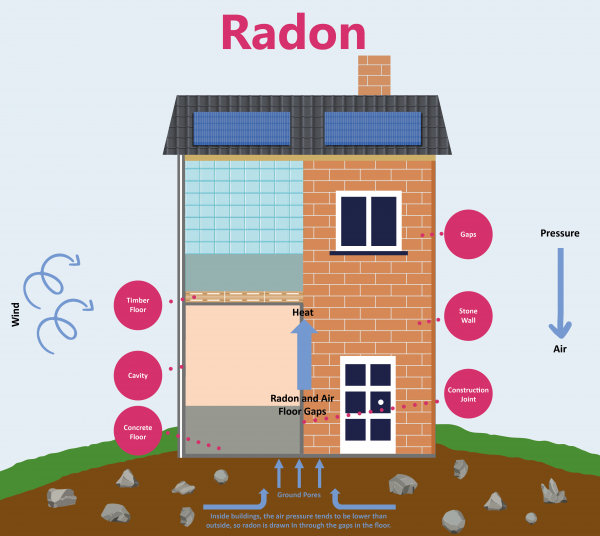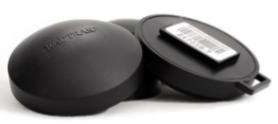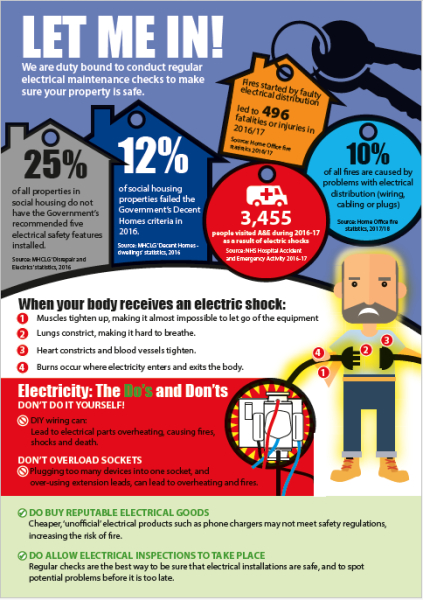Building Safety
There is nothing more important to us than the safety of you and your family.
Here at South Lakes housing, we are committed to providing a safe environment for our tenants to live in.
-
Gas Servicing
We are responsible for carrying out an annual gas service to all appliances belonging to us within your home.
This service checks the safety of the appliance. Faulty appliances can emit harmful carbon monoxide fumes or natural gas can escape which may cause an explosion. You and your family could be at risk if these safety checks are not carried out.
We must comply with Gas Safety Regulations which places the legal duty upon us to carry out a gas service check every 12 months.
If you do not have your gas appliances and gas pipe work in your home serviced and checked by our contractors every year, you may not be safe. Faulty gas appliances can produce carbon monoxide, high amounts of which can kill in minutes.
South Lakes Housing run a gas service programme every year. We will ask you to let us into your home to carry out this work. We have a legal responsibility to do this work every year, so we take it very seriously. This means we can make sure you are safe and it will only cost a few hours of your time (this is better than it costing you your life!).
WHY DO SLH CARRY OUT A GAS SERVICE?
Regulation 36 of the ‘Gas Safety (Installation & Use) Regulation 1998’ says that we, as landlords, should make sure that we check every gas appliance and flue for safety within 12 months of installing them and not leave it more than 12 months before we inspect them again.
WHAT DOES THE GAS ENGINEER DO ON THEIR SERVICE VISIT EVERY YEAR?
The engineer should arrive at the time they have pre-arranged with you and should show you their identification card to prove who they are.
The engineer will ask you questions about where any gas appliances are in your home and whether you have any problems with how these appliances work.
The engineer will ask you where the gas meter is and before they start work, test the meter and gas appliances for leaks.
DURING THE WORK
- The engineer will protect the area they are working in and the appliances (for example – by using a dust sheet).
- The engineer should take the appliances apart and clean them using a vacuum cleaner, where necessary. Please remember, they will completely remove gas fires from the wall, check and clean them. However, if your fire is room-sealed (where any vents go through to the outside of the building), they will not need to do this.
- The engineer will only carry out a service to Council supplied and installed appliances. They will carry out a safety check to any tenant owned appliances.
- The engineer will check the flue connection to the appliance. This may include going outside or into the loft space to carry out an inspection.
- The engineer will put the appliance back together again.
- The engineer will check to see if the appliance works. If the appliance passes the appropriate tests, the engineer will leave it in working order, if it safe to do so.
- The engineer will ask you to sign a Landlords Gas Safety Record that they have filled in. If they need to do any more work, they will tell you. They will also provide you with a copy of the signed form to keep in a safe place.
- When they have finished all the servicing work, the engineer will tidy their equipment away and leave the property.
WHAT SHOULD I DO IN AN EMERGENCY?
If you smell gas or fumes, you should:
- If you are calling from a mobile phone, go outside of the property first
- Do NOT smoke, do NOT turn light switches on or off and do NOT do anything to create a spark
- Turn off the supply meter. If you do not have to switch on a light to do so, open doors and windows and wait outside for an emergency engineer to arrive
Contact the National Grid Gas Emergency Service on 0800 111 999 and South Lakes Housing Customer Services on 0300 303 8540 so that we can arrange for an engineer to take action where necessary.
-
Asbestos
Asbestos was commonly used in building materials when our properties were built years ago.
Asbestos can be found in floor tiles, artex ceilings, garages and communal areas. It is only when asbestos is moved or damaged it could become a problem. If you think a building material is asbestos – do not panic, just ask us for help.
The asbestos found in our properties is routinely tested and is very low risk to health. We carry out surveys to our homes and whenever a tenant ends their tenancy, we take advantage of the opportunity of the property being empty to test whether there is asbestos present and remove where necessary.
Ask for information and advice before carrying out any repairs or drilling. If you wish to report asbestos to us, then please contact us.
For more information on asbestos please read our information leaflet – Asbestos Leaflet
-
Fire Safety
As your landlord, fire safety is a top priority for us and we work very hard to ensure that our homes are as safe as possible.
It’s important to familiarise yourself with the exit routes for your home, what the fire policy is whether to ‘Stay Put’ or ‘Evacuate’ and how to call the Fire Service in the event of a fire.
There are lots of things you can to do to stop a fire from happening in your home. If you want to make sure that you’re safe or know more about what you should do in the event of a fire, then take a look at our tips below.
If you have any concerns about fire safety in your home, please contact our Customer hub on 0300 303 8540 or send us an email to customerservices@southlakeshousing.co.uk -
Radon
We are undertaking a Radon testing programme, starting with our properties located in areas of higher exposure, through to medium and then low. We will be re-testing all homes over a 5 year period. We will contact all our customers to advise them of their Radon exposure level and what actions might be required to their homes. Further information about Radon, its health risks and areas affected can be found on the Public Health England Website.

What is radon?
Radon is a colourless, odourless radioactive gas. It is formed by the radioactive decay of small amounts of uranium that occur naturally in all rocks and soils. The amount of radon is measured in becquerels per cubic metre of air (Bq m-3). The average level in UK homes is 20 Bq m-3.
Where is Radon Found?
Radon is everywhere. Radon levels outdoors are low everywhere but levels indoors can be higher. For most homes the risk to peoples health is small.
Public Health England has published a UK map showing areas affected by radon, to see the map click here. The darker the colour on the radon maps, the greater the chance of a high level in a building. However, not all buildings, even in the darkest areas, have high levels.Our exposure to radiation
We are all exposed to radiation from natural and man-made sources. Just 20 Bq m-3 (the average radon level in UK homes) gives us half our exposure to radiation from all sources. Every building contains radon, but the levels are usually low. The chances of higher levels depend on the type of ground. Radon levels vary between neighbouring homes and with different living styles.
What is low level?
Radon levels over 200 Bq m-3 will require action to reduce this level. We will undertake all the necessary works required to reduce the level to below 100 Bq m-3
What is the action level for Radon?
Public Health England measures radon levels in Becquerel per cubic metres of air (Bq m-3). Any reading of 100 Bq m-3 in homes will be considered the ‘Action Level’. This is the level at which action should be taken to reduce the radon concentration.
What do Radon test look like?
The testing is done by a small passive plastic sensor. This lives in a room for three months and takes in any Radon gas, which is then tested in a laboratory for the amount of radon gas that it has absorbed over the three months. It doesn’t need connection to power or anything else during this time. It can be ignored and forgotten about until it needs collection.

-
Electrical Safety
Electrical Safety – Keeping you Safe.
Poor electrical safety can have devastating effects and government is committed to ensuring that social residents are safe in their homes. The Grenfell Tower tragedy in 2017 started with an electrical fire caused by a fridge-freezer in 2020/21 in England, there were sadly 55 deaths resulting from fires ignited by electrical appliances or installations and in the last 10 years there have been 788 fatalities from such fires. Electrical safety issues can be difficult to detect with the naked eye, but there are steps government can take to raise standards and improve safety for social housing residents.
We do not know exactly how many fires occur in social homes, but data provided by the London Fire Brigade shows that a disproportionately high number of electrical fires in London attended by the Fire Investigation Team in the past 5 years, happened in social homes. Between 2015/16 and 2016-17, 2% of social renters had a fire at home over those 2 years, compared with 1% of owner occupiers.
In 2020/21 there were 14,858 accidental electrical dwelling fires in England, 37% of which were caused by faults. Of these 14,858 fires, the 3 most common sources were cooking appliances (56%), electrical distribution (installations, wiring, etc) (19%) and other domestic-style appliances (such as white goods, electronic chargers, etc) (14%).
79% of fires caused by other domestic style appliances are caused by faults.
You can view our Electrical Safety Leaflet above by clicking here.
Electrical Inspection – at least every 5 Years.
At SLH we are responsible for carrying out an electrical inspection at least every 5 years to ensure all electrics in your home are safe. This service checks the safety of all electrical installations in the property, such as light fittings, sockets, and the consumer unit. We will produce a detailed report from the inspection and rectify any faults identified. If you ever notice a problem with any of your electrics contact our customer services team on 0300 303 8540 who will be happy to assist you.
You will be contacted 2 months before the last certificate expires by our contractor BES Group who will arrange a suitable time for the inspection to take place. There may be occasions where there are specialist parts required or more time required for remedial works. If this happens, the engineer will reattend within 10 working days, on a day that suits you to rectify any problems.
This inspection can take 3–4 hours to complete. It would be helpful if you could ensure that the areas surrounding light switches and plug sockets are accessible and clear before the engineer visits. The works are not intrusive, if extensive works are required, we will discuss this with you at the time of attendance.
Will it affect my tenancy if I don’t allow access for an Electrical Installation Condition Report (EICR) to be undertaken?
- Preventing access for these essential works may put your tenancy at risk – it is part of our landlord safety checks to undertake EICR on a regular basis. SLH will identify and rectify any faults that may have appeared over time since the last time the electrics to your property were inspected.
- We will attempt to undertake these inspections as part of the process and work closely with our customers to achieve compliance. If we are unable to complete this work, we will refer to our tenancy management/enforcement team.
Frequently Asked Questions – Electrical Saftey
What is an EICR?
- An Electrical Inspection Condition Report is a check that as your landlord we complete to ensure all electrics are safe within your home. We will produce a detailed report from the inspection and rectify any faults identified.
What will happen when an EICR takes place within my property?
- Our contractor will contact you to arrange an appointment for the works to be undertaken.
How long does an EICR take to complete?
- This inspection can take 3 – 4 hours to complete. The engineer will check every plug socket and fitting within the property. Do I need to prepare before an engineer attends my property?
- It would be helpful if you could ensure that the areas surrounding light switches and plug sockets are accessible and clear to allow the inspection to take place
When will you contact me to advise when an EICR is due?
- These checks are completed every 5 years. You will be contacted 2 months before the current certificate expires.
What if there are works required that are unable to be completed at the visit?
- There may be occasions where there are specialist parts required or more time required for remedial works. If this happens we will arrange an appointment within 5 working days to complete these.



